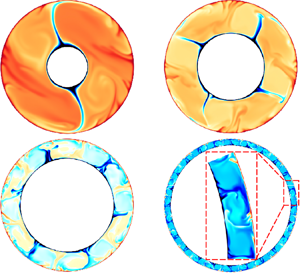Article contents
Effects of radius ratio on annular centrifugal Rayleigh–Bénard convection
Published online by Cambridge University Press: 10 November 2021
Abstract

We report on a three-dimensional direct numerical simulation study of flow structure and heat transport in the annular centrifugal Rayleigh–Bénard convection (ACRBC) system, with cold inner and hot outer cylinders corotating axially, for the Rayleigh number range  $Ra \in [{10^6},{10^8}]$ and radius ratio range
$Ra \in [{10^6},{10^8}]$ and radius ratio range  $\eta = {R_i}/{R_o} \in [0.3,0.9]$ (
$\eta = {R_i}/{R_o} \in [0.3,0.9]$ ( $R_i$ and
$R_i$ and  $R_o$ are the radius of the inner and outer cylinders, respectively). This study focuses on the dependence of flow dynamics, heat transport and asymmetric mean temperature fields on the radius ratio
$R_o$ are the radius of the inner and outer cylinders, respectively). This study focuses on the dependence of flow dynamics, heat transport and asymmetric mean temperature fields on the radius ratio  $\eta$. For the inverse Rossby number
$\eta$. For the inverse Rossby number  $Ro^{-1} = 1$, as the Coriolis force balances inertial force, the flow is in the inertial regime. The mechanisms of zonal flow revolving in the prograde direction in this regime are attributed to the asymmetric movements of plumes and the different curvatures of the cylinders. The number of roll pairs is smaller than the circular roll hypothesis as the convection rolls are probably elongated by zonal flow. The physical mechanism of zonal flow is verified by the dependence of the drift frequency of the large-scale circulation (LSC) rolls and the space- and time-averaged azimuthal velocity on
$Ro^{-1} = 1$, as the Coriolis force balances inertial force, the flow is in the inertial regime. The mechanisms of zonal flow revolving in the prograde direction in this regime are attributed to the asymmetric movements of plumes and the different curvatures of the cylinders. The number of roll pairs is smaller than the circular roll hypothesis as the convection rolls are probably elongated by zonal flow. The physical mechanism of zonal flow is verified by the dependence of the drift frequency of the large-scale circulation (LSC) rolls and the space- and time-averaged azimuthal velocity on  $\eta$. The larger
$\eta$. The larger  $\eta$ is, the weaker the zonal flow becomes. We show that the heat transport efficiency increases with
$\eta$ is, the weaker the zonal flow becomes. We show that the heat transport efficiency increases with  $\eta$. It is also found that the bulk temperature deviates from the arithmetic mean temperature and the deviation increases as
$\eta$. It is also found that the bulk temperature deviates from the arithmetic mean temperature and the deviation increases as  $\eta$ decreases. This effect can be explained by a simple model that accounts for the curvature effects and the radially dependent centrifugal force in ACRBC.
$\eta$ decreases. This effect can be explained by a simple model that accounts for the curvature effects and the radially dependent centrifugal force in ACRBC.
- Type
- JFM Papers
- Information
- Copyright
- © The Author(s), 2021. Published by Cambridge University Press
References
REFERENCES
Wang et al. supplementary movie 1
The movie shows the time series (total 100t) of the temperature fields on a \phi-r-plane for radius ratio η = 0.3 at Ra = 10^7
- 19
- Cited by



